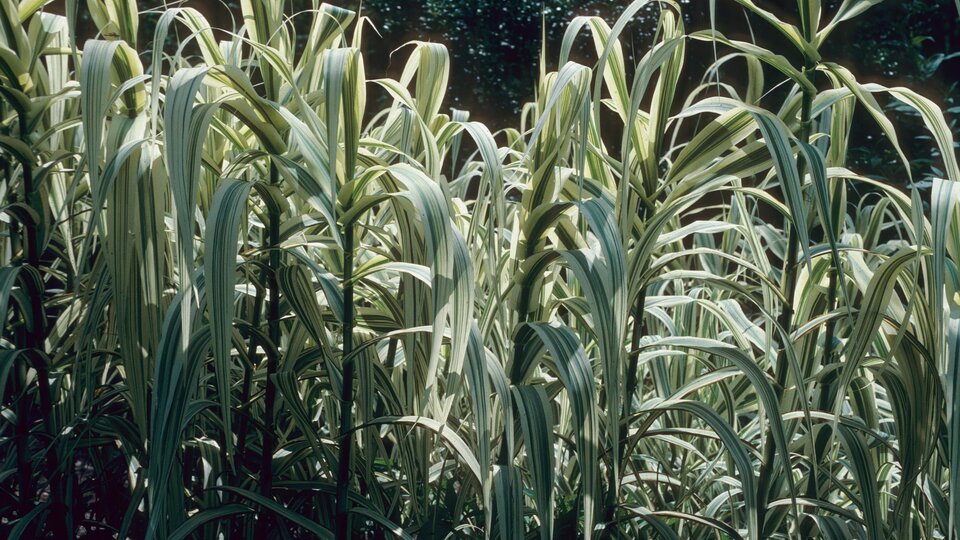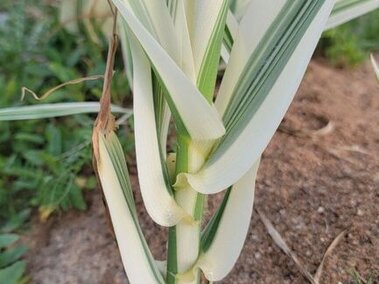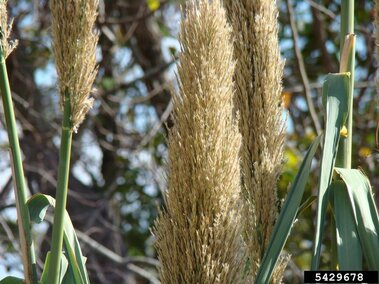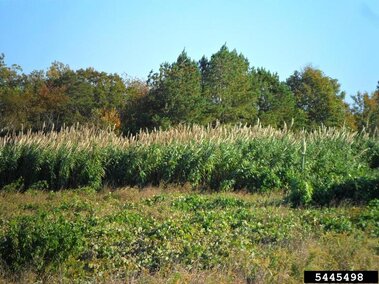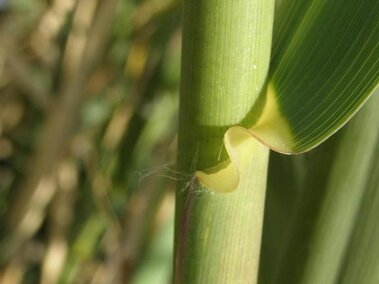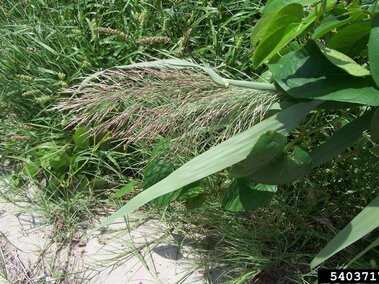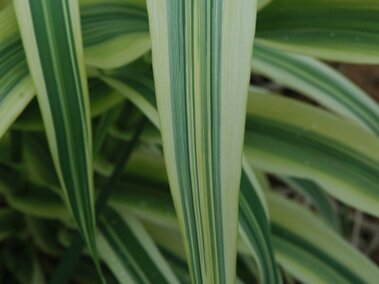General Information
Species Name: Arundo donax
Also Known As: giant cane, Georgia cane, Spanish reed, switch cane, wild cane
Family: Poaceae (Grass)
Growth Form: Grass
Life Span: Perennial
Flowering Dates: July-September
Origin: Eurasia and Africa
Toxic: No
Category 1: Priority Aquatic Invasive Species
Why Is It Invasive?
Giant reed invades wetlands such as ditches, stream banks and lake shores. It competes for water, nutrients and radiation, suppresses and excludes native vegetation which degrades wildlife habitat, increases fire risks and interferes with flood control.
What Does It Look Like?
General Characteristics
Giant reed can reach up to 20 ft. (6.1 m) in height, although it can be much shorter when damaged or stressed.
Flowers
Long, dense, plumes of whorled stemmed flowers develop at the top of the culms, reaching to 36 inches long occur July through September.
Leaves
Blue-green alternate leaves are long, flat, grow up to 1-2 inches wide and 12 inches long. They can be green or have variegated green and white stripes the length of the blade.
Stems
The stem resembles a corn stalk and may be 1/4 to 2 inches thick.
Seeds
No fruits or seeds typically outside of its native range. The plant spreads through rhizomes and stem nodes that come in contact with the soil.
Photos
Where Does It Grow?
It forms dense stands where water accumulates such as wetlands, stream banks, ditches, and disturbed sites. It may be found planted in landscapes. It grows best in well-drained soils where abundant moisture is available. It tolerates a wide variety of conditions, including high salinity, and can flourish in many soil types from heavy clays to loose sands. It occurs on upland sites as scattered dense clumps along roadsides and forest margins, migrating from old home plantings by displaced rhizome fragments.
How Does It Spread?
Giant reed was probably first introduced into the United States at Los Angeles, California in the early 1800's. Since then, it has become widely dispersed into all of the subtropical and warm temperate areas of the world, mostly through intentional human introductions. Today, giant reed is widely planted throughout the warmer areas of the United States as an ornamental and in the Southwest, where it is used along ditches for erosion control. Giant reed has a variety of uses ranging from music to medicine. Primitive pipe organs were made from it and the reeds for woodwind instruments are still made from its culms, for which no satisfactory substitutes are known. It is also used in basketry, for fishing rods, livestock fodder, medicine, and soil erosion control.
How Do I Control It?
Management of invasive aquatic plants involving either mechanical removal of plants or application of herbicides to public waters requires a permit. Contact the Contact the Nebraska Game and Parks Commission for more information.
Mechanical
Mechanical control of areas with giant reed is usually more effective when used in combination with chemical control and the planting and/or seeding of desired native species as follow-up. Large-scale mechanical control usually causes major soil disturbance and interferes with native plant establishment. In some cases, there may be an increase invasion from other noxious weeds on cleared sites that will require additional later management
Hand removal is very difficult, but digging can be used to target individual plants (usually < 6 feet tall). To improve handling, first cut the canopy near the surface by using a chain saw, machete, or pruning shears before pulling up the remaining portions of reed stems, rhizomes, and roots. Shovels, mattocks, or pick-ax are the most commonly used tools. The root mass and associated rhizomes must be entirely removed from the soil. Loose, rain-moistened soils are most conducive to hand pulling. Uprooted material should be removed or burned onsite to prevent rerooting. Bag and dispose of plants in a dumpster or burn. Frequent repeated cutting to groundline may result in control.
Excavating using a backhoe or excavator and grapple can be used to remove small, dense stands of giant reed. Precutting is not necessary since the long stems may be an aid to pull up roots. Excavating is not recommended in the streambed or edge because root material may be washed downstream.
Cultural
Do not plant.
Chemical
Please refer to the 2025 Guide for Weed, Disease and Insect Management in Nebraska or contact your county weed control authority.
What Should I Do If I See It in Nebraska?
If you see giant reed in Nebraska, you should report it to the Nebraska Game and Parks Commission's Aquatic Invasive Species (AIS) Program using their AIS Report Form. For guidance on what information to include in your report, check out our reporting tips.
References and More Information
A Field Guide for the Identification of Invasive Plants in Southern Forests - USDA Forest Service
Center for Invasive Species and Ecosystem Health
Nebraska Game and Parks Commission
Weeds Gone Wild: Alien Plant Invaders of Natural Areas - Plant Conservation Alliance
Weed of the Week - USDA Forest Service
